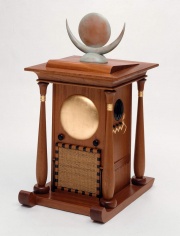Difference between revisions of "Latex paint"
| (One intermediate revision by the same user not shown) | |||
| Line 2: | Line 2: | ||
== Description == | == Description == | ||
| − | The term 'Latex' has been commonly, but confusingly, applied by commercial manufacturers to aqueous emulsions of synthetic resins that dry by water evaporation. It is most often used for house paints. The term originated in the 1940s when a water-based paint with a rubber binder was introduced. Later aqueous emulsions of other resins (such as [[acrylic resin|acrylic]], [[styrene-butadiene rubber|styrene-butadiene]], [[polyvinyl acetate]], [[polyurethane]], [[Alkyd resin| | + | The term 'Latex' has been commonly, but confusingly, applied by commercial manufacturers to aqueous emulsions of synthetic resins that dry by water evaporation. It is most often used for house paints. The term originated in the 1940s when a water-based paint with a [[rubber]] binder was introduced. Later aqueous emulsions of other resins (such as [[acrylic resin|acrylic]], [[styrene-butadiene rubber|styrene-butadiene]], [[polyvinyl acetate]], [[polyurethane]], [[Alkyd resin|Alkyd]] and [[epoxy]]) replaced the natural rubber binder, while the latex name was retained. Synthetic water-based 'latex' paints are made by emulsion polymerization. They are more properly called [[emulsion paint|emulsion paints]] or polymer dispersion paints. |
== Synonyms and Related Terms == | == Synonyms and Related Terms == | ||
| Line 11: | Line 11: | ||
* ''Paint in America'', Robert Moss (ed.), John Wiley & Sons, New York, 1994 Comment: M.Phillips, "A Survey of Paint Technolology" | * ''Paint in America'', Robert Moss (ed.), John Wiley & Sons, New York, 1994 Comment: M.Phillips, "A Survey of Paint Technolology" | ||
| − | * Monona Rossol, 'Water-Based Latex Paints' | + | * Monona Rossol, 'Water-Based Latex Paints', in handout for NYCOSH webinar on paints, 2019. |
* ASTM, "Standard Terminology Relating to Paint, Varnish, Lacquer and Related Products", Annual Book of ASTM Standards, Section 6, Paints, Related Coatings and Aromatics, ASTM, D16, 7-Jan, Jul-96 | * ASTM, "Standard Terminology Relating to Paint, Varnish, Lacquer and Related Products", Annual Book of ASTM Standards, Section 6, Paints, Related Coatings and Aromatics, ASTM, D16, 7-Jan, Jul-96 | ||
* ''Dictionary of Building Preservation'', Ward Bucher, ed., John Wiley & Sons, Inc., New York City, 1996 | * ''Dictionary of Building Preservation'', Ward Bucher, ed., John Wiley & Sons, Inc., New York City, 1996 | ||
Latest revision as of 14:19, 4 June 2023
Description
The term 'Latex' has been commonly, but confusingly, applied by commercial manufacturers to aqueous emulsions of synthetic resins that dry by water evaporation. It is most often used for house paints. The term originated in the 1940s when a water-based paint with a Rubber binder was introduced. Later aqueous emulsions of other resins (such as acrylic, styrene-butadiene, Polyvinyl acetate, Polyurethane, Alkyd and Epoxy) replaced the natural rubber binder, while the latex name was retained. Synthetic water-based 'latex' paints are made by emulsion polymerization. They are more properly called emulsion paints or polymer dispersion paints.
Synonyms and Related Terms
rubber-based paint; water-based paint; emulsion paint; polymer dispersion paint; pintura latex (Esp.); tinta de latex (Port.)
Resources and Citations
- Paint in America, Robert Moss (ed.), John Wiley & Sons, New York, 1994 Comment: M.Phillips, "A Survey of Paint Technolology"
- Monona Rossol, 'Water-Based Latex Paints', in handout for NYCOSH webinar on paints, 2019.
- ASTM, "Standard Terminology Relating to Paint, Varnish, Lacquer and Related Products", Annual Book of ASTM Standards, Section 6, Paints, Related Coatings and Aromatics, ASTM, D16, 7-Jan, Jul-96
- Dictionary of Building Preservation, Ward Bucher, ed., John Wiley & Sons, Inc., New York City, 1996
- Pam Hatchfield, Pollutants in the Museum Environment, Archetype Press, London, 2002
- The American Heritage Dictionary or Encarta, via Microsoft Bookshelf 98, Microsoft Corp., 1998
- Art and Architecture Thesaurus Online, https://www.getty.edu/research/tools/vocabulary/aat/, J. Paul Getty Trust, Los Angeles, 2000
